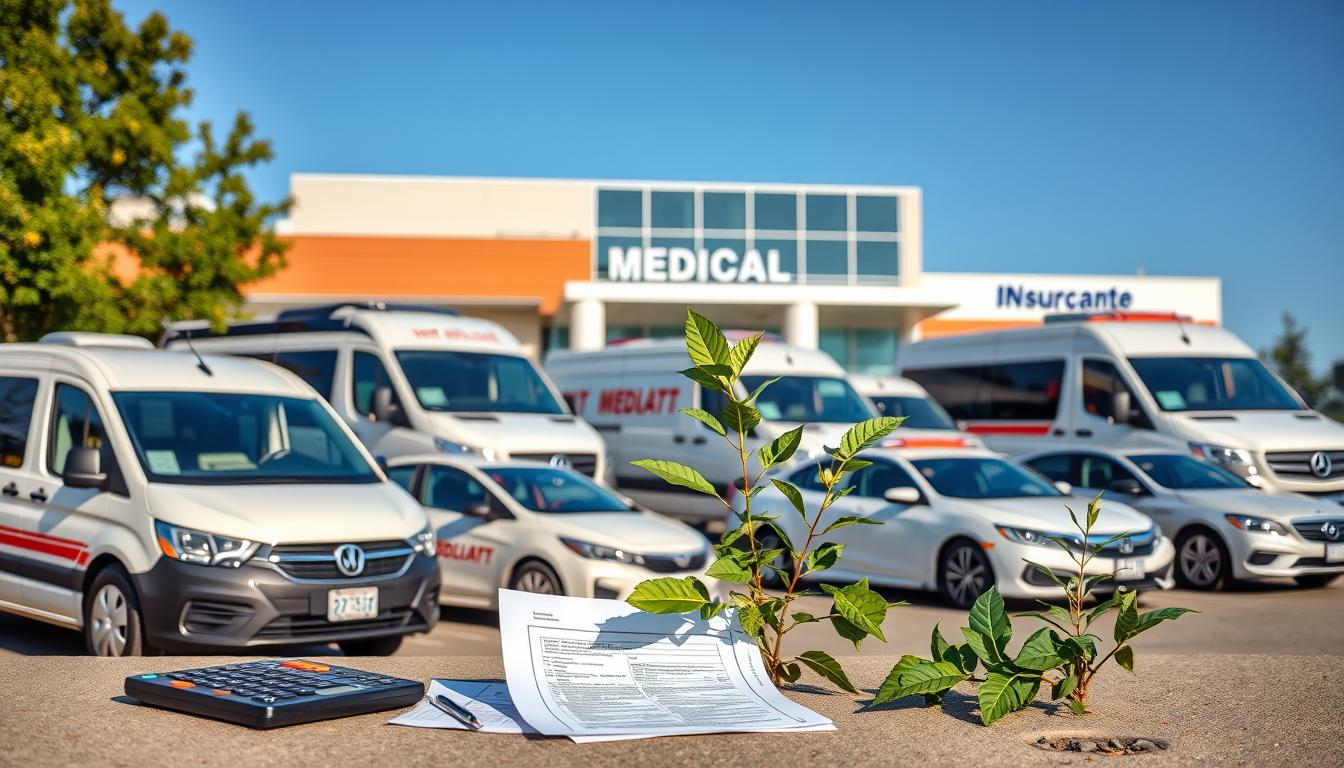Running a Non-Emergency Medical Transportation (NEMT) business is costly, especially for insurance. Premiums can be from $4,200 to $18,000 per vehicle each year. It’s important to find ways to cut costs without losing coverage.
Several things affect your insurance rates. These include how many vehicles you have, your drivers’ records, and the condition of your cars. Also, you must follow state and federal insurance rules, which might mean more coverage than regular car insurance.
To save money, keep your vehicles in good shape, hire qualified drivers, and add safety features. Using NEMT software for scheduling and billing can also help. Talking to insurance agents and comparing prices can help you find the best deals for your business. For more tips, check here.
Key Takeaways
- Regular vehicle maintenance and preventive care can significantly reduce NEMT insurance costs.
- Well-trained employees improve efficiency and help in maintaining lower insurance premiums.
- Implementing NEMT software solutions can automate processes and reduce administrative expenses.
- Consulting with insurance agents and comparing quotes is essential for finding the best coverage options.
- Strategic partnerships with healthcare providers can create cost-saving opportunities.
Understanding NEMT Insurance: Basics and Importance
Non-Emergency Medical Transportation (NEMT) insurance is key for businesses that transport people to medical appointments. It’s different from regular car insurance because it covers more for the vehicles and people being transported. Knowing about NEMT insurance and its options is crucial for keeping your business safe.
Why NEMT Insurance is Essential
Running an NEMT service has its own set of risks. NEMT insurance gives financial protection against accidents and legal issues. It’s especially important because NEMT services often carry people who need special care. Insurance companies like Progressive offer special plans for NEMT services.
Without the right insurance, businesses could face big financial problems. This could even lead to shutting down operations and losing client trust.
“Insurance policies for NEMT aim to balance budget considerations with the need for comprehensive coverage to protect the business adequately.” – Progressive
Types of NEMT Insurance Coverage
There are many types of coverage for NEMT providers:
- Commercial Auto Liability: Covers injuries and damages caused by company vehicles.
- Comprehensive Coverage: Protects against non-collision damages like theft or natural disasters.
- Hired Auto and Non-Owned Auto Coverage: Helps with financial risks from leased or rented vehicles.
- Uninsured Motorist Coverage: Protects against accidents with drivers who don’t have insurance.
- Personal Injury Protection (PIP): Covers medical costs for driver and passengers in accidents.
- Workers’ Compensation: Provides benefits for employees hurt on the job, varying by state.
- Professional Liability Insurance: Covers mistakes in NEMT services.
- Umbrella Insurance: Offers extra liability coverage for unexpected costs.
- Sexual Abuse & Molestation Insurance: Protects against abuse claims during transport, especially for children.
- Assault & Battery Insurance: Covers claims from physical or sexual altercations during service.
To learn more about NEMT insurance, visit this detailed resource. Insurance costs for NEMT depend on many factors, like location and driving history. Businesses can also get discounts for things like experience and paying upfront.
A good NEMT auto insurance policy is key for following state rules and building trust with clients. It shows your commitment to safety and reliability.
Factors Influencing NEMT Insurance Costs
Knowing what affects NEMT insurance costs can help you manage expenses. Important factors include fleet size, vehicle condition, driver safety, and where services are offered.
Fleet Size and Vehicle Condition
The fleet size greatly impacts NEMT insurance costs. A bigger fleet means more chances of accidents, which can increase costs. The condition of your vehicles also matters; newer, safer vehicles might get you lower rates.
Adding vehicles like wheelchair vans can also change costs. These vans are pricier to insure because they carry a higher risk of injury.
Driver Records and Experience
Driver safety records and experience are key. Drivers with lots of experience and a clean record can lower your insurance costs. On the other hand, drivers with accidents or tickets can raise costs.
So, it’s smart to invest in defensive driving and safety training. This not only makes your service safer but also shows insurers your drivers are reliable, which can lower your premiums.
Geographical Locations and Service Areas
The area where you operate affects insurance costs. Urban areas with lots of traffic usually have higher premiums than rural ones. Insurers look at local accident rates and claim history too.
So, knowing how different areas affect costs can help you better manage your insurance. This way, you can prepare for and handle your NEMT insurance expenses more effectively.
The Role of Fleet Maintenance in Reducing Premiums
Keeping your fleet in top shape is key to lowering your Non-Emergency Medical Transportation (NEMT) insurance costs. Regular maintenance and servicing are crucial. They ensure your vehicles are safe and reliable, which can greatly reduce your insurance costs.
Regular Vehicle Maintenance
Vehicle maintenance is more than just fixing things when they break. It’s a detailed, ongoing process of inspections and services. This keeps your NEMT fleet in the best condition. Regular maintenance prevents unexpected breakdowns and reduces the chance of expensive accidents. Here are some ways it helps:
- Improved Safety: Keeping all vehicle parts in good condition lowers the risk of accidents caused by mechanical issues.
- Longer Vehicle Lifespan: Regular services can make your vehicles last longer, saving money on early replacements.
- Operational Efficiency: Well-maintained vehicles perform better and are more reliable. This reduces downtime and improves service.
Incorporating Advanced Safety Features
Adding advanced safety features to your NEMT fleet can significantly lower insurance costs. Features like GPS tracking, collision avoidance sensors, and telematics technology improve safety and provide useful data for improvement. Some benefits include:
- Real-Time Monitoring: GPS tracking gives real-time insights into vehicle locations, helping to optimize routes and improve efficiency.
- Lower Accident Rates: Collision avoidance systems can greatly reduce accident risks.
- Usage-Based Insurance (UBI): Sharing telematics data with insurers can lead to lower premiums through UBI models. This links insurance costs to actual vehicle use and driver behavior.
By following these practices, NEMT providers can see a significant drop in insurance costs. Both regular maintenance and advanced safety features are smart investments. They make your operations more efficient and safer from an insurance standpoint.
| Benefits | Strategies |
|---|---|
| NEMT Insurance Cost Reduction | Regular Vehicle Maintenance, Incorporating Advanced Safety Features |
| Enhanced Vehicle Safety | GPS Tracking, Collision Avoidance Systems |
| Operational Efficiency | Telematics Technology, Real-Time Monitoring |
| Extended Vehicle Lifespan | Routine Servicing, Proactive Inspections |
Strategies for Safe Driving and Accident Prevention
Creating strong strategies for safe driving and accident prevention is key for NEMT companies. It keeps passengers and drivers safe and helps lower insurance costs.
Implementing Driver Training Programs
Driver training is essential for safe driving practices. NEMT companies should offer formal training like PASS. This teaches drivers how to handle passengers with medical needs safely.
Having regular safety meetings and retraining keeps drivers up-to-date. This reduces accident risks and lowers insurance costs.
Using NEMT Software for Fleet Management
Using NEMT fleet management software is a smart move for safety and efficiency. GPS and advanced software let you track vehicles in real-time. This helps monitor driver behavior and vehicle conditions.
This proactive approach prevents accidents and saves on insurance costs. It shows a commitment to safety.
Adding technologies like high-end cameras and EDRs makes operations more transparent. This lowers the chance of big claims.
By focusing on safe driving practices and using driver training and NEMT software, NEMT companies can create a safe culture. This leads to lower insurance costs and better operations.
Benefits of Comparing Insurance Quotes
For non-emergency medical transportation (NEMT) businesses, comparing insurance quotes is key. It helps find the best coverage at a good price. Smaller businesses with fewer drivers usually pay less for insurance.
The Value of Consulting with Insurance Agents
Talking to NEMT insurance agents is very helpful. They know a lot about state insurance regulations. They can help you find the best policy for your business.
They consider your specific needs and look for discounts. This can lower your insurance costs.
Understanding State-Specific Requirements
State rules greatly affect NEMT insurance needs. Some states only work with certain providers. This changes what insurance you need.
In Georgia, for example, Logisticare and Southeast Trans have special rules. Knowing these rules helps you choose the right insurance.
| Insurance Provider | Annual Premium Range | Coverage Features |
|---|---|---|
| Provider A | $4,000 – $6,000 | Basic liability, comprehensive, collision |
| Provider B | $5,000 – $8,000 | Increased policy limits, lower deductibles |
| Provider C | $7,000 – $11,000 | Full coverage, including worker’s compensation |
By comparing insurance quotes, NEMT businesses can find great rates and coverage. Working with NEMT insurance agents ensures you follow all state insurance regulations. This way, you get the best insurance for your business.
How Higher Deductibles Can Reduce NEMT Insurance Costs
In the world of Non-Emergency Medical Transportation (NEMT) insurance, it’s key to understand deductibles and premiums. Choosing higher deductibles can lower monthly premiums. This can lead to big savings if managed well.
Pros and Cons of Higher Deductibles
Many NEMT businesses choose higher deductibles for lower annual premiums. This can save money right away. But, there are downsides:
- Lower Premiums: Higher deductibles mean lower monthly premiums. This gives NEMT providers more cash flow.
- Out-of-Pocket Costs: With higher deductibles, you pay more out-of-pocket during claims. This can be tough if you have many claims in a year.
- Financial Risk Management: You need to carefully manage your finances. Make sure you can handle these costs if claims happen.
Evaluating Financial Risk and Savings
Finding the right deductible level is a delicate balance. Here are important things to think about:
- Financial Capability: Check your business’s financial health. Can you afford higher deductibles if you need to?
- Risk Tolerance: Know how much risk your company can handle. How much are you willing to risk for lower premiums?
- Historical Claims Data: Look at past claims to guess future ones. See if the savings from higher deductibles are worth the risk of higher costs.
For NEMT businesses, choosing higher deductibles needs careful thought. Weighing the pros and cons helps make smart choices. These choices should fit your business’s financial situation and risk level.
Leveraging Technology to Optimize Routes
Using technology in NEMT is changing how Non-Emergency Medical Transportation (NEMT) works. New scheduling and routing systems help cut down on miles, fuel, and wear on vehicles. This boosts your business’s efficiency and helps it last longer.
Knowing how key route optimization is can make your service more reliable. With advanced NEMT tech, your dispatch and scheduling get smoother. This saves money and makes your clients trust you more.
Mobile tech also makes your team talk better and faster. It gives you updates in real-time, so you can handle any issue quickly. Using data analytics helps you make smarter choices and see where you can get better.
Think about this: using tech to plan routes can cut down on fuel costs. Switching to fuel-efficient or hybrid vehicles can save a lot of money over time. These steps make your business run better and keep you in line with rules like HIPAA.
| Benefits of Technology in NEMT | Impact on Operations |
|---|---|
| Fuel Efficiency | Reduces miles traveled and fuel consumption |
| Real-Time Updates | Enhances operational response and reliability |
| Data Analytics | Optimizes resources and identifies improvement areas |
| Automated Scheduling | Streamlines processes, reduces manual intervention |
Strategic Partnerships and Their Impact on Insurance Costs
In the NEMT industry, strategic partnerships can greatly affect insurance costs. Working with healthcare providers and NEMT industry suppliers can lead to big savings. These partnerships bring in more customers, lower risks, and make services more efficient.
Partnering with Healthcare Providers
Teaming up with healthcare providers can secure long-term contracts and steady income. These partnerships help align services, reducing downtime. They also make it easier to get better insurance rates, as providers see them as less risky.
Good billing and insurance processes can cut costs by up to 30%. This shows the financial benefits of these partnerships.
Negotiating Better Terms with Suppliers
Working with NEMT industry suppliers can also lead to better deals. Buying in bulk or signing long-term agreements can save money. NEMT businesses can get discounts and efficient services by sharing resources.
Building partnerships can save 10-15% through shared resources and expanded services. Here are some strategies for better terms:
| Strategy | Details | Cost Savings Potential |
|---|---|---|
| Bulk Purchasing | Large orders of essential supplies | 15-20% |
| Long-Term Contracts | Extended agreements with suppliers | 10-12% |
| Resource Sharing | Collaborating with other businesses | 10-15% |
| Vendor Discounts | Negotiated lower rates | 5-10% |
By using these strategies, your NEMT business can lower insurance costs. It can also improve service and customer satisfaction.
Conclusion
Managing NEMT business costs well means knowing how different things affect insurance prices. This includes keeping vehicles in good shape, driving safely, using new technology, and forming strong partnerships. Using top-notch NEMT software and regular car upkeep boosts safety and cuts down on insurance costs.
Looking for the best insurance deals from companies like AARP and Blue Cross/Blue Shield can save a lot of money. Working with insurance agents is also key. They help understand state rules and keep operations smooth. Choosing higher deductibles can lower premiums, but it’s important to think about the risks.
A successful NEMT operation relies on being honest with insurance, training drivers well, and keeping vehicles safe. Even though Medicare and Medicaid pay for a lot of NEMT services, it’s smart to check each ride’s coverage to avoid surprises. By combining these strategies, NEMT businesses can grow and stay profitable. This way, they can keep offering vital services while staying financially stable.
FAQ
Why is NEMT insurance essential for my business?
NEMT insurance is a must for any business that offers medical transportation. It protects you from financial loss and legal trouble after accidents. It also covers your vehicles, drivers, attendants, and passengers.
What types of coverage are included in a NEMT auto insurance policy?
A NEMT auto insurance policy can include several types of coverage. These include liability for commercial use, comprehensive coverage, and protection for vehicles you don’t own. It also covers uninsured motorists and personal injury protection.
How does fleet size and vehicle condition affect NEMT insurance premiums?
A bigger fleet means more chances of accidents, which can raise your insurance costs. The age and condition of your vehicles, plus any special equipment, also play a big role. Keeping your vehicles in good shape and relatively new can help lower your premiums.
How do driver records and experience influence the cost of NEMT insurance?
Drivers with clean records and lots of experience can lower your insurance costs. Insurers see them as less risky, which means lower premiums. On the other hand, drivers with bad records can increase your costs due to higher accident risks.
What impact do geographical locations and service areas have on NEMT insurance costs?
Where you operate can affect your insurance costs. Areas with more traffic or accidents tend to have higher premiums. State laws also vary, which can influence your rates.
How can regular vehicle maintenance help reduce NEMT insurance costs?
Keeping your vehicles well-maintained can lower your insurance costs. Insurers see well-kept vehicles as safer, which can lead to lower premiums.
What are the benefits of incorporating advanced safety features in NEMT vehicles?
Adding advanced safety features can make your vehicles safer and lower your insurance costs. These features reduce the risk of accidents, making your vehicles more appealing to insurers.
How can implementing driver training programs help manage NEMT insurance costs?
Driver training programs, like the PASS program, can teach safe driving habits. Trained drivers are less likely to get into accidents, which can save you money on insurance.
How can NEMT software aid in fleet management and cost savings?
NEMT software helps with scheduling, dispatching, and billing. It also lets you monitor vehicle safety and maintenance needs in real-time. This can help manage risks and save on insurance costs.
Why is it important to compare insurance quotes for NEMT services?
Comparing insurance quotes helps you find the best rates. Working with insurance agents who know NEMT can also help you understand state laws and find ways to save on insurance.
What are the pros and cons of choosing higher insurance deductibles?
Higher deductibles can lower your premiums but mean you’ll pay more out of pocket during claims. Weighing the savings against your ability to handle claims is key to making a good choice.
How does route optimization technology benefit NEMT operations?
Route optimization technology can cut down on mileage, fuel use, and costs. It also helps reduce accident risks and wear on vehicles, which can lower your insurance premiums.
How can strategic partnerships help reduce NEMT insurance costs?
Partnerships with healthcare providers and suppliers can bring in steady customers and lower costs. These partnerships can also lead to better deals with suppliers and lower insurance costs.


